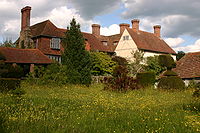
Great Dixter
Encyclopedia

Northiam
Northiam is a village and civil parish in the Rother District of East Sussex, England. The village is located thirteen miles north of Hastings in the valley of the River Rother. The main road that passes through it is the A28 which goes to Canterbury and Hastings.-Governance:The lowest level of...
, East Sussex
East Sussex
East Sussex is a county in South East England. It is bordered by the counties of Kent, Surrey and West Sussex, and to the south by the English Channel.-History:...
close to the South Coast of England
England
England is a country that is part of the United Kingdom. It shares land borders with Scotland to the north and Wales to the west; the Irish Sea is to the north west, the Celtic Sea to the south west, with the North Sea to the east and the English Channel to the south separating it from continental...
. It has a famous garden which is regarded as the epitome of English plantsmanship.
House

Northiam
Northiam is a village and civil parish in the Rother District of East Sussex, England. The village is located thirteen miles north of Hastings in the valley of the River Rother. The main road that passes through it is the A28 which goes to Canterbury and Hastings.-Governance:The lowest level of...
, which dates from the mid 15th century, was acquired by a businessman named Nathaniel Lloyd in 1909. He had a 16th century house in a similar style moved from Kent
Kent
Kent is a county in southeast England, and is one of the home counties. It borders East Sussex, Surrey and Greater London and has a defined boundary with Essex in the middle of the Thames Estuary. The ceremonial county boundaries of Kent include the shire county of Kent and the unitary borough of...
and the two were combined with new work by the architect Edwin Lutyens
Edwin Lutyens
Sir Edwin Landseer Lutyens, OM, KCIE, PRA, FRIBA was a British architect who is known for imaginatively adapting traditional architectural styles to the requirements of his era...
to create a much larger house, which was rechristened Great Dixter. It is a romantic recreation of a medieval manor house
Manor house
A manor house is a country house that historically formed the administrative centre of a manor, the lowest unit of territorial organisation in the feudal system in Europe. The term is applied to country houses that belonged to the gentry and other grand stately homes...
, complete with great hall
Great hall
A great hall is the main room of a royal palace, nobleman's castle or a large manor house in the Middle Ages, and in the country houses of the 16th and early 17th centuries. At that time the word great simply meant big, and had not acquired its modern connotations of excellence...
, parlour
Parlour
Parlour , from the French word parloir, from parler , denotes an "audience chamber". In parts of the United Kingdom and the United States, parlours are common names for certain types of food service houses, restaurants or special service areas, such as tattoo parlors...
, solar
Solar (room)
The solar was a room in many English and French medieval manor houses, great houses and castles, generally situated on an upper storey, designed as the family's private living and sleeping quarters...
and yeoman's hall.
Garden
Nathaniel Lloyd and LutyensEdwin Lutyens
Sir Edwin Landseer Lutyens, OM, KCIE, PRA, FRIBA was a British architect who is known for imaginatively adapting traditional architectural styles to the requirements of his era...
began the garden at Great Dixter, but it was Nathaniel's son Christopher Lloyd
Christopher Lloyd (gardener)
Christopher Hamilton Lloyd, OBE was a British gardener and author. He was the 20th Century chronicler for the heavily planted, labour-intensive, country garden.-Life:...
, a well known garden writer and television personality, who made it famous. The garden is in the arts and crafts
Arts and crafts
Arts and crafts comprise a whole host of activities and hobbies that are related to making things with one's hands and skill. These can be sub-divided into handicrafts or "traditional crafts" and "the rest"...
style, and features topiary
Topiary
Topiary is the horticultural practice of training live perennial plants, by clipping the foliage and twigs of trees, shrubs and subshrubs to develop and maintain clearly defined shapes, perhaps geometric or fanciful; and the term also refers to plants which have been shaped in this way. It can be...
, a long border, an orchard and a wild flower meadow. The planting is profuse, yet structured, and has featured many bold experiments of form, colour and combination. The garden is currently managed by Fergus Garrett, who worked closely with Lloyd up until his death in 2006 as Head Gardener and introduced a number of innovations into the planting scheme. In the grounds of Great Dixter is an early oast house
Oast house
An oast, oast house or hop kiln is a building designed for kilning hops as part of the brewing process. They can be found in most hop-growing areas and are often good examples of vernacular architecture...
.
Management
The house and garden are open to the public on a regular basis and study tours are available. A charity called the Great Dixter Charitable Trust has been established to ensure that the property is preserved.External links
50.997278°N 0.591930°W

